Marketing Intelligence Report: NEXT Plc Market Analysis and Strategies
VerifiedAdded on 2020/01/07
|20
|5414
|27
Report
AI Summary
This report delves into the marketing intelligence strategies employed by NEXT Plc, a prominent retail company. It begins with an introduction to marketing intelligence and its importance in today's fluctuating markets. The report then explores the stages of the purchase decision-making process, various buyer behavior theories, and the circumstances influencing purchaser behavior, including cultural, social, personal, and psychological factors. It also examines brand loyalty, corporate image, and repeat purchasing. The report outlines market research objectives, techniques, and the use of secondary data, including internal and external sources. It presents a customer satisfaction survey and reviews its success. The analysis includes competitor analysis, SWOT analysis, and market size trends. Overall, the report provides a comprehensive overview of how NEXT Plc utilizes marketing intelligence to maintain its competitive edge and understand its customer base.
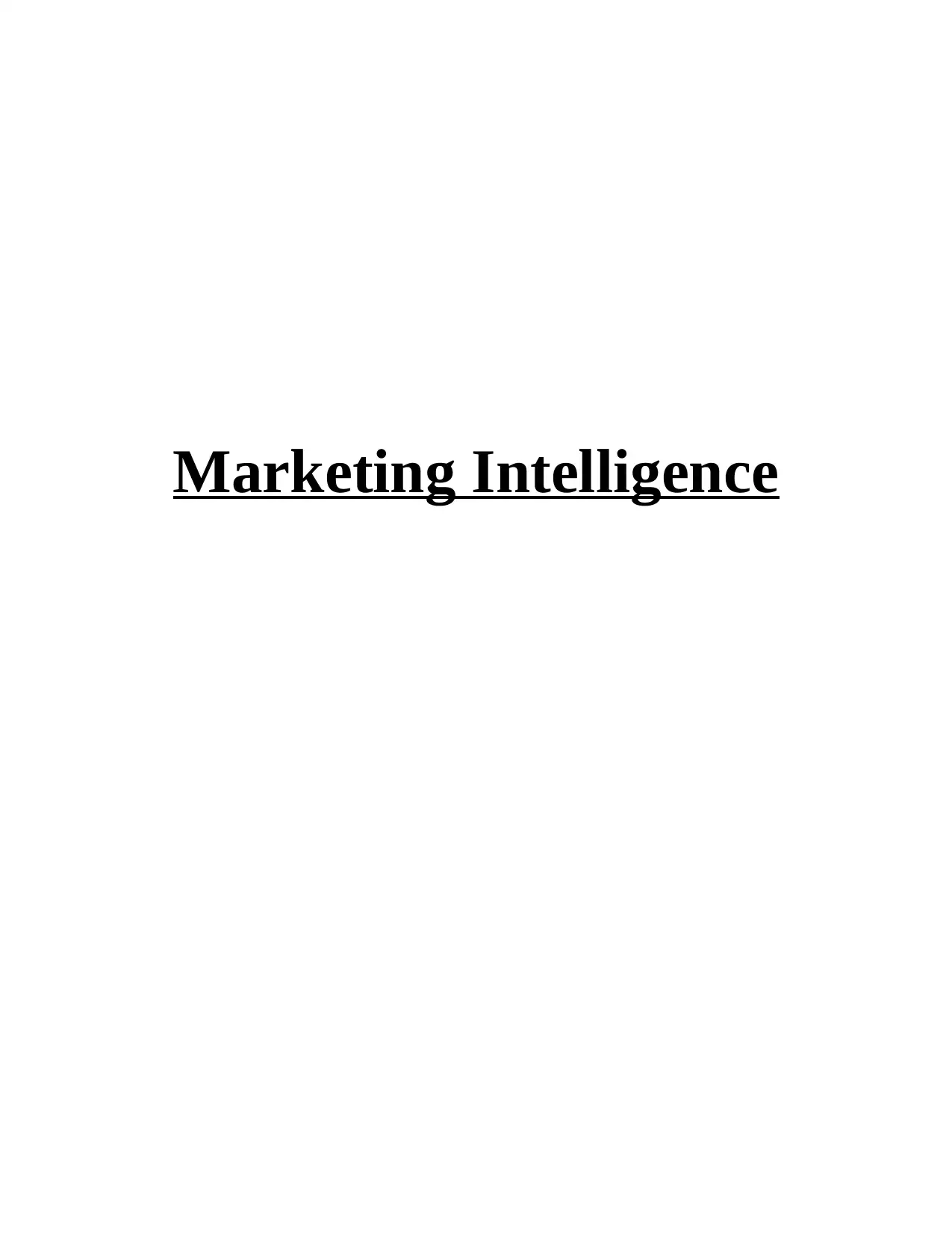
Marketing Intelligence
Paraphrase This Document
Need a fresh take? Get an instant paraphrase of this document with our AI Paraphraser
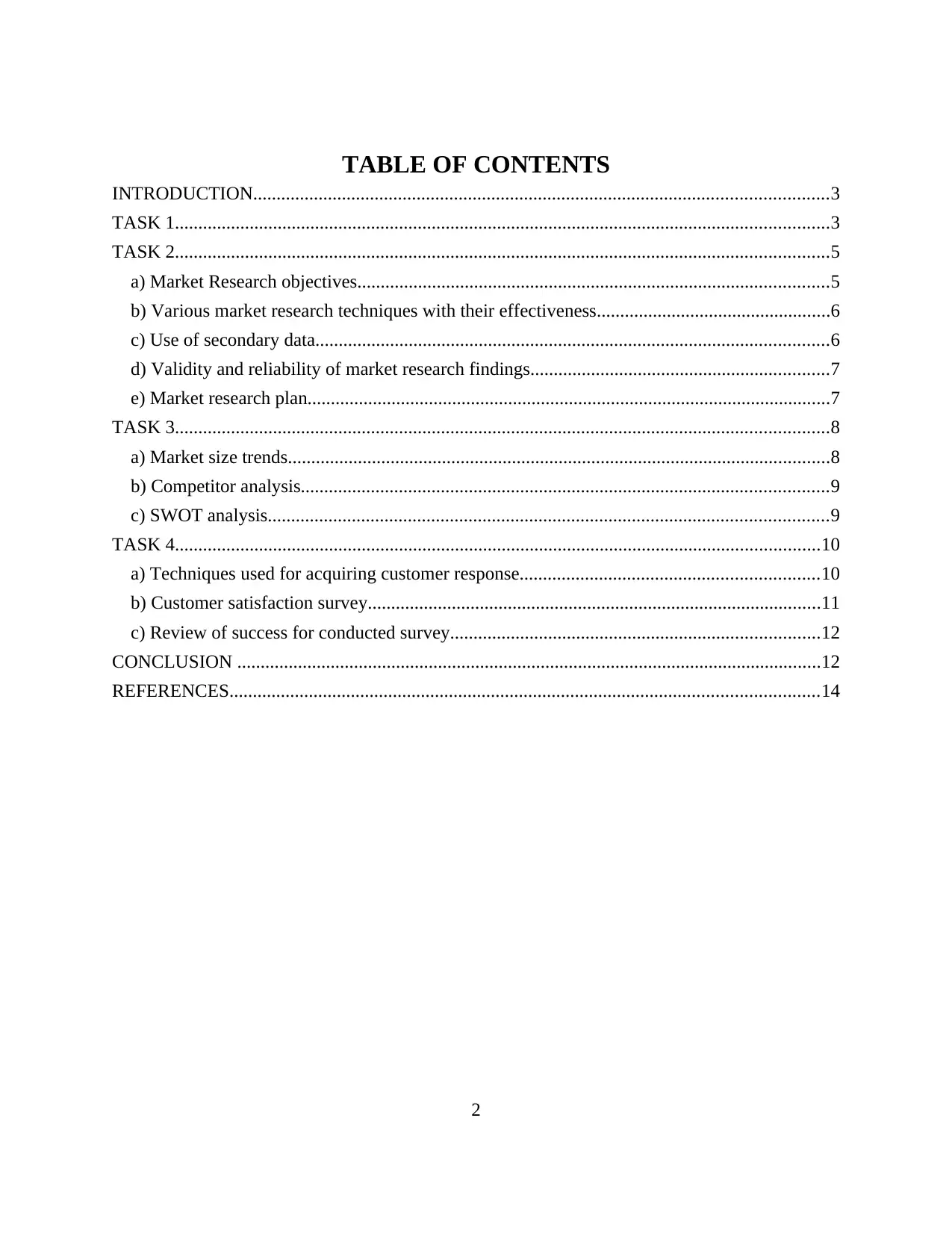
TABLE OF CONTENTS
INTRODUCTION...........................................................................................................................3
TASK 1............................................................................................................................................3
TASK 2............................................................................................................................................5
a) Market Research objectives.....................................................................................................5
b) Various market research techniques with their effectiveness..................................................6
c) Use of secondary data..............................................................................................................6
d) Validity and reliability of market research findings................................................................7
e) Market research plan................................................................................................................7
TASK 3............................................................................................................................................8
a) Market size trends....................................................................................................................8
b) Competitor analysis.................................................................................................................9
c) SWOT analysis........................................................................................................................9
TASK 4..........................................................................................................................................10
a) Techniques used for acquiring customer response................................................................10
b) Customer satisfaction survey.................................................................................................11
c) Review of success for conducted survey...............................................................................12
CONCLUSION .............................................................................................................................12
REFERENCES..............................................................................................................................14
2
INTRODUCTION...........................................................................................................................3
TASK 1............................................................................................................................................3
TASK 2............................................................................................................................................5
a) Market Research objectives.....................................................................................................5
b) Various market research techniques with their effectiveness..................................................6
c) Use of secondary data..............................................................................................................6
d) Validity and reliability of market research findings................................................................7
e) Market research plan................................................................................................................7
TASK 3............................................................................................................................................8
a) Market size trends....................................................................................................................8
b) Competitor analysis.................................................................................................................9
c) SWOT analysis........................................................................................................................9
TASK 4..........................................................................................................................................10
a) Techniques used for acquiring customer response................................................................10
b) Customer satisfaction survey.................................................................................................11
c) Review of success for conducted survey...............................................................................12
CONCLUSION .............................................................................................................................12
REFERENCES..............................................................................................................................14
2
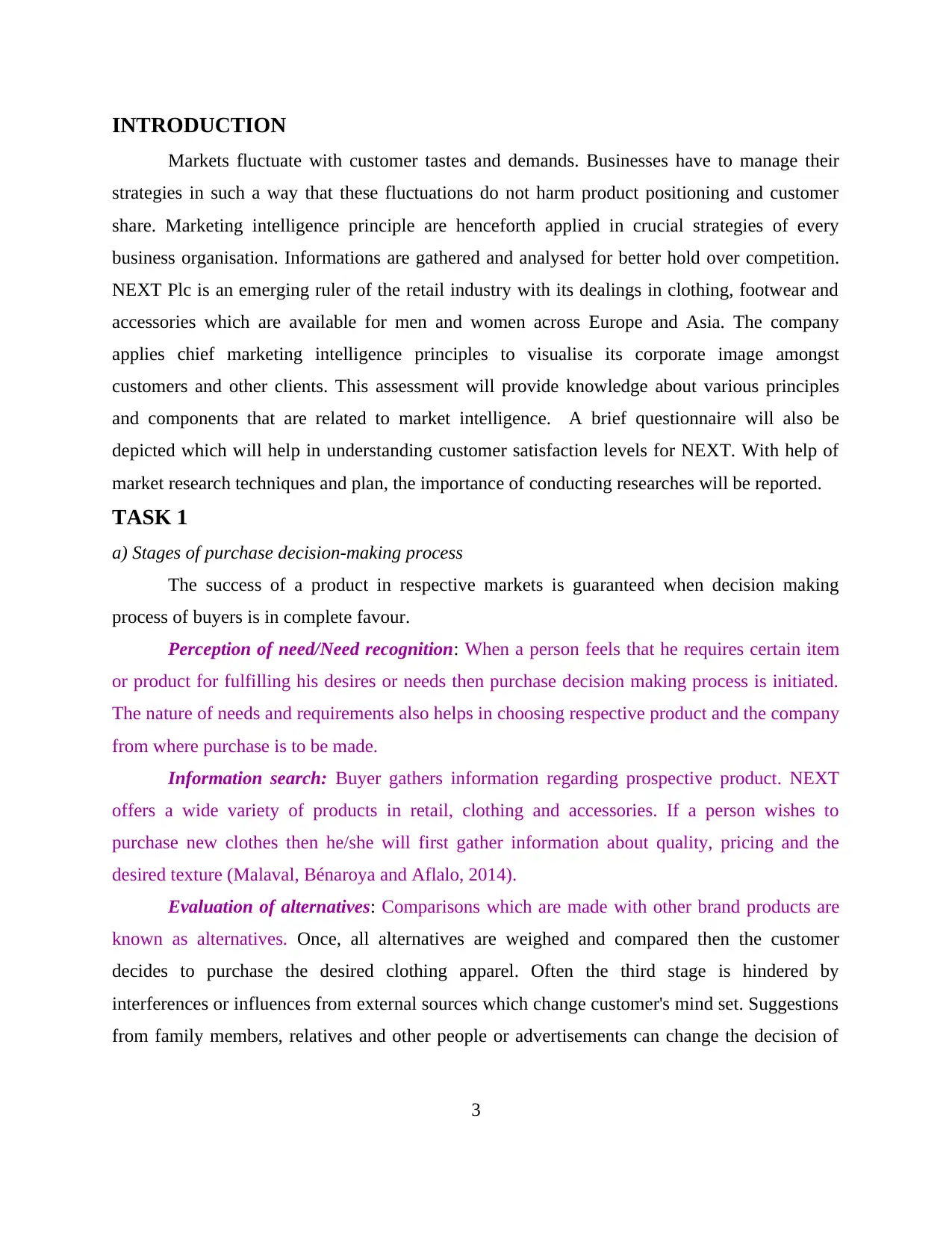
INTRODUCTION
Markets fluctuate with customer tastes and demands. Businesses have to manage their
strategies in such a way that these fluctuations do not harm product positioning and customer
share. Marketing intelligence principle are henceforth applied in crucial strategies of every
business organisation. Informations are gathered and analysed for better hold over competition.
NEXT Plc is an emerging ruler of the retail industry with its dealings in clothing, footwear and
accessories which are available for men and women across Europe and Asia. The company
applies chief marketing intelligence principles to visualise its corporate image amongst
customers and other clients. This assessment will provide knowledge about various principles
and components that are related to market intelligence. A brief questionnaire will also be
depicted which will help in understanding customer satisfaction levels for NEXT. With help of
market research techniques and plan, the importance of conducting researches will be reported.
TASK 1
a) Stages of purchase decision-making process
The success of a product in respective markets is guaranteed when decision making
process of buyers is in complete favour.
Perception of need/Need recognition: When a person feels that he requires certain item
or product for fulfilling his desires or needs then purchase decision making process is initiated.
The nature of needs and requirements also helps in choosing respective product and the company
from where purchase is to be made.
Information search: Buyer gathers information regarding prospective product. NEXT
offers a wide variety of products in retail, clothing and accessories. If a person wishes to
purchase new clothes then he/she will first gather information about quality, pricing and the
desired texture (Malaval, Bénaroya and Aflalo, 2014).
Evaluation of alternatives: Comparisons which are made with other brand products are
known as alternatives. Once, all alternatives are weighed and compared then the customer
decides to purchase the desired clothing apparel. Often the third stage is hindered by
interferences or influences from external sources which change customer's mind set. Suggestions
from family members, relatives and other people or advertisements can change the decision of
3
Markets fluctuate with customer tastes and demands. Businesses have to manage their
strategies in such a way that these fluctuations do not harm product positioning and customer
share. Marketing intelligence principle are henceforth applied in crucial strategies of every
business organisation. Informations are gathered and analysed for better hold over competition.
NEXT Plc is an emerging ruler of the retail industry with its dealings in clothing, footwear and
accessories which are available for men and women across Europe and Asia. The company
applies chief marketing intelligence principles to visualise its corporate image amongst
customers and other clients. This assessment will provide knowledge about various principles
and components that are related to market intelligence. A brief questionnaire will also be
depicted which will help in understanding customer satisfaction levels for NEXT. With help of
market research techniques and plan, the importance of conducting researches will be reported.
TASK 1
a) Stages of purchase decision-making process
The success of a product in respective markets is guaranteed when decision making
process of buyers is in complete favour.
Perception of need/Need recognition: When a person feels that he requires certain item
or product for fulfilling his desires or needs then purchase decision making process is initiated.
The nature of needs and requirements also helps in choosing respective product and the company
from where purchase is to be made.
Information search: Buyer gathers information regarding prospective product. NEXT
offers a wide variety of products in retail, clothing and accessories. If a person wishes to
purchase new clothes then he/she will first gather information about quality, pricing and the
desired texture (Malaval, Bénaroya and Aflalo, 2014).
Evaluation of alternatives: Comparisons which are made with other brand products are
known as alternatives. Once, all alternatives are weighed and compared then the customer
decides to purchase the desired clothing apparel. Often the third stage is hindered by
interferences or influences from external sources which change customer's mind set. Suggestions
from family members, relatives and other people or advertisements can change the decision of
3
⊘ This is a preview!⊘
Do you want full access?
Subscribe today to unlock all pages.

Trusted by 1+ million students worldwide
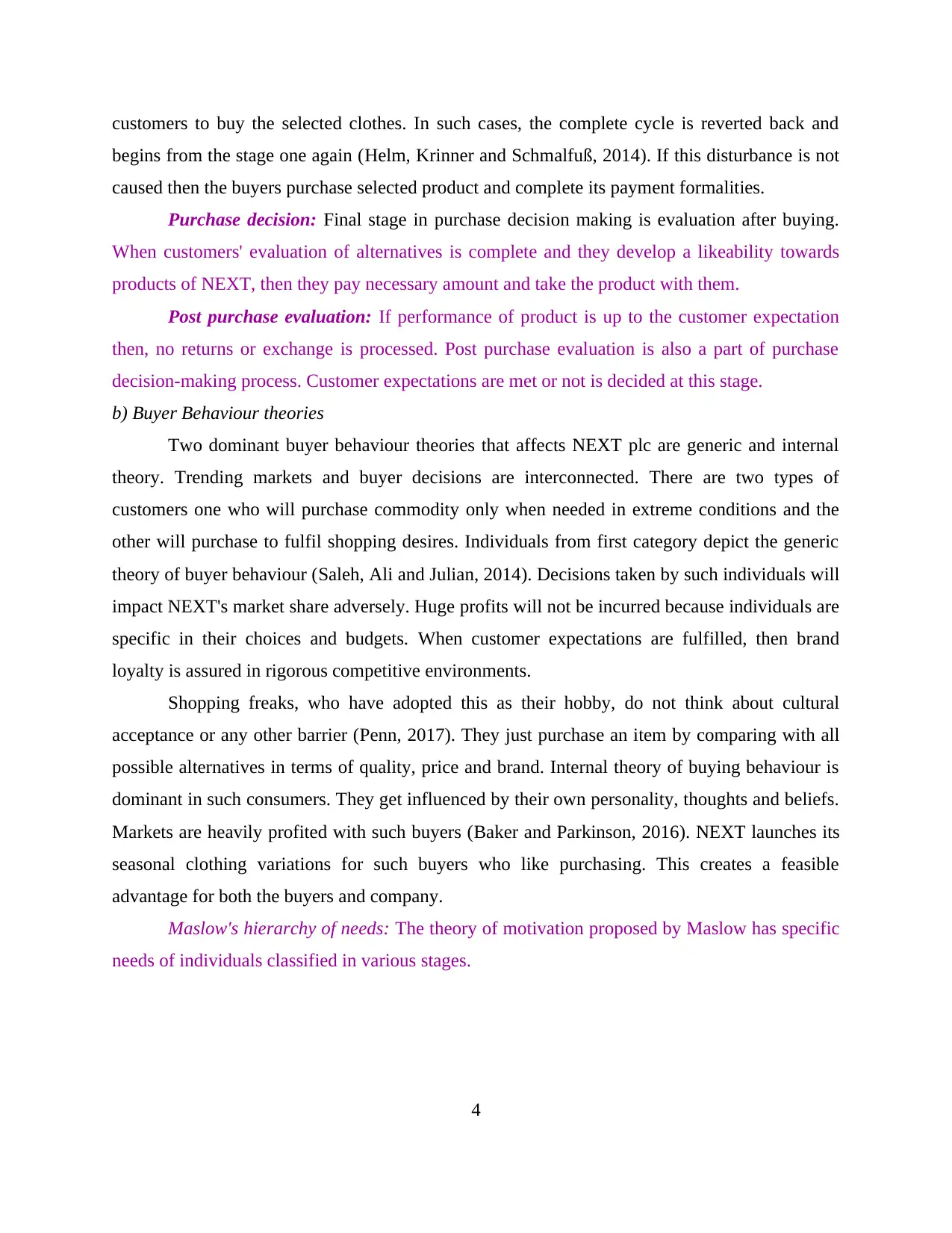
customers to buy the selected clothes. In such cases, the complete cycle is reverted back and
begins from the stage one again (Helm, Krinner and Schmalfuß, 2014). If this disturbance is not
caused then the buyers purchase selected product and complete its payment formalities.
Purchase decision: Final stage in purchase decision making is evaluation after buying.
When customers' evaluation of alternatives is complete and they develop a likeability towards
products of NEXT, then they pay necessary amount and take the product with them.
Post purchase evaluation: If performance of product is up to the customer expectation
then, no returns or exchange is processed. Post purchase evaluation is also a part of purchase
decision-making process. Customer expectations are met or not is decided at this stage.
b) Buyer Behaviour theories
Two dominant buyer behaviour theories that affects NEXT plc are generic and internal
theory. Trending markets and buyer decisions are interconnected. There are two types of
customers one who will purchase commodity only when needed in extreme conditions and the
other will purchase to fulfil shopping desires. Individuals from first category depict the generic
theory of buyer behaviour (Saleh, Ali and Julian, 2014). Decisions taken by such individuals will
impact NEXT's market share adversely. Huge profits will not be incurred because individuals are
specific in their choices and budgets. When customer expectations are fulfilled, then brand
loyalty is assured in rigorous competitive environments.
Shopping freaks, who have adopted this as their hobby, do not think about cultural
acceptance or any other barrier (Penn, 2017). They just purchase an item by comparing with all
possible alternatives in terms of quality, price and brand. Internal theory of buying behaviour is
dominant in such consumers. They get influenced by their own personality, thoughts and beliefs.
Markets are heavily profited with such buyers (Baker and Parkinson, 2016). NEXT launches its
seasonal clothing variations for such buyers who like purchasing. This creates a feasible
advantage for both the buyers and company.
Maslow's hierarchy of needs: The theory of motivation proposed by Maslow has specific
needs of individuals classified in various stages.
4
begins from the stage one again (Helm, Krinner and Schmalfuß, 2014). If this disturbance is not
caused then the buyers purchase selected product and complete its payment formalities.
Purchase decision: Final stage in purchase decision making is evaluation after buying.
When customers' evaluation of alternatives is complete and they develop a likeability towards
products of NEXT, then they pay necessary amount and take the product with them.
Post purchase evaluation: If performance of product is up to the customer expectation
then, no returns or exchange is processed. Post purchase evaluation is also a part of purchase
decision-making process. Customer expectations are met or not is decided at this stage.
b) Buyer Behaviour theories
Two dominant buyer behaviour theories that affects NEXT plc are generic and internal
theory. Trending markets and buyer decisions are interconnected. There are two types of
customers one who will purchase commodity only when needed in extreme conditions and the
other will purchase to fulfil shopping desires. Individuals from first category depict the generic
theory of buyer behaviour (Saleh, Ali and Julian, 2014). Decisions taken by such individuals will
impact NEXT's market share adversely. Huge profits will not be incurred because individuals are
specific in their choices and budgets. When customer expectations are fulfilled, then brand
loyalty is assured in rigorous competitive environments.
Shopping freaks, who have adopted this as their hobby, do not think about cultural
acceptance or any other barrier (Penn, 2017). They just purchase an item by comparing with all
possible alternatives in terms of quality, price and brand. Internal theory of buying behaviour is
dominant in such consumers. They get influenced by their own personality, thoughts and beliefs.
Markets are heavily profited with such buyers (Baker and Parkinson, 2016). NEXT launches its
seasonal clothing variations for such buyers who like purchasing. This creates a feasible
advantage for both the buyers and company.
Maslow's hierarchy of needs: The theory of motivation proposed by Maslow has specific
needs of individuals classified in various stages.
4
Paraphrase This Document
Need a fresh take? Get an instant paraphrase of this document with our AI Paraphraser
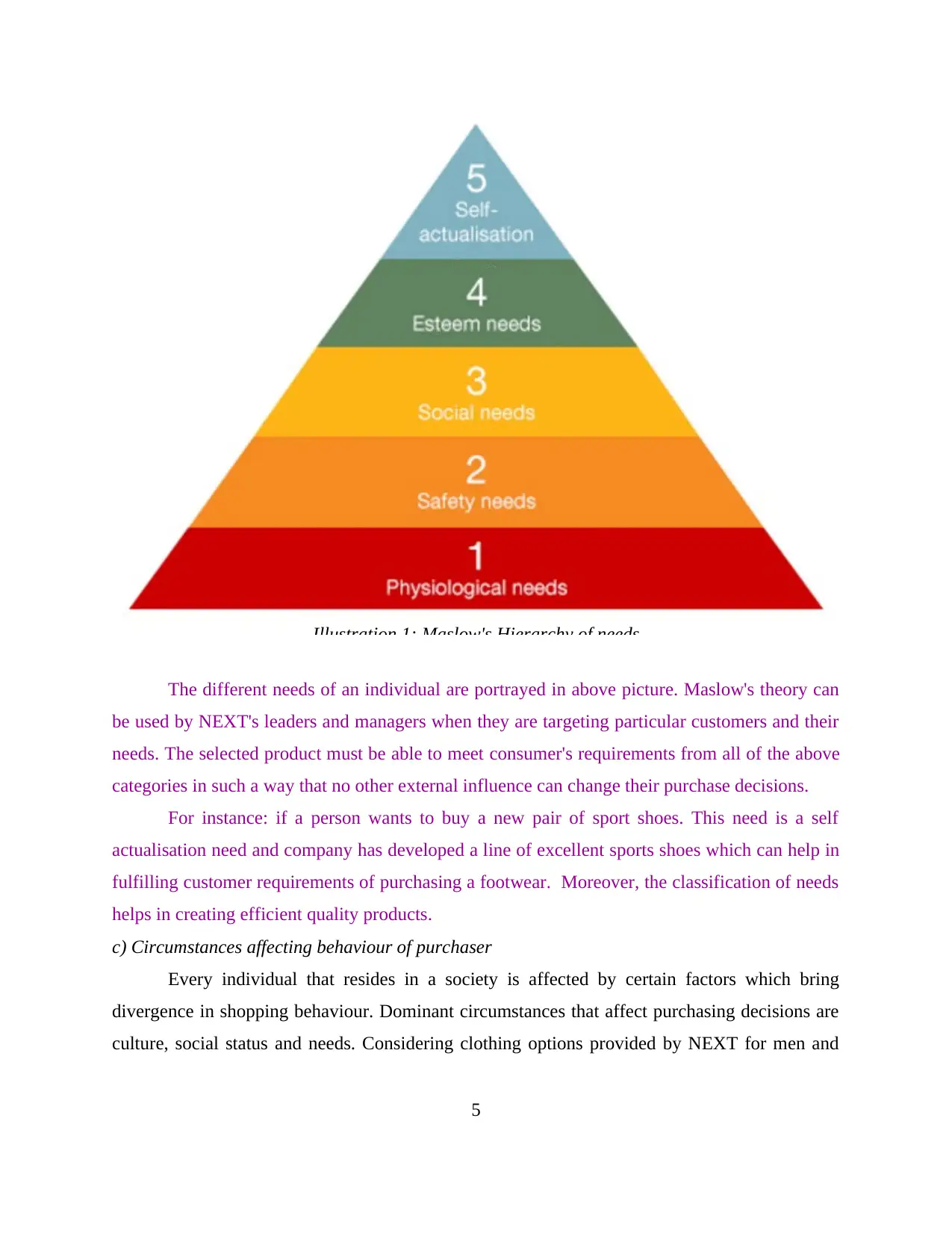
The different needs of an individual are portrayed in above picture. Maslow's theory can
be used by NEXT's leaders and managers when they are targeting particular customers and their
needs. The selected product must be able to meet consumer's requirements from all of the above
categories in such a way that no other external influence can change their purchase decisions.
For instance: if a person wants to buy a new pair of sport shoes. This need is a self
actualisation need and company has developed a line of excellent sports shoes which can help in
fulfilling customer requirements of purchasing a footwear. Moreover, the classification of needs
helps in creating efficient quality products.
c) Circumstances affecting behaviour of purchaser
Every individual that resides in a society is affected by certain factors which bring
divergence in shopping behaviour. Dominant circumstances that affect purchasing decisions are
culture, social status and needs. Considering clothing options provided by NEXT for men and
5
Illustration 1: Maslow's Hierarchy of needs
be used by NEXT's leaders and managers when they are targeting particular customers and their
needs. The selected product must be able to meet consumer's requirements from all of the above
categories in such a way that no other external influence can change their purchase decisions.
For instance: if a person wants to buy a new pair of sport shoes. This need is a self
actualisation need and company has developed a line of excellent sports shoes which can help in
fulfilling customer requirements of purchasing a footwear. Moreover, the classification of needs
helps in creating efficient quality products.
c) Circumstances affecting behaviour of purchaser
Every individual that resides in a society is affected by certain factors which bring
divergence in shopping behaviour. Dominant circumstances that affect purchasing decisions are
culture, social status and needs. Considering clothing options provided by NEXT for men and
5
Illustration 1: Maslow's Hierarchy of needs
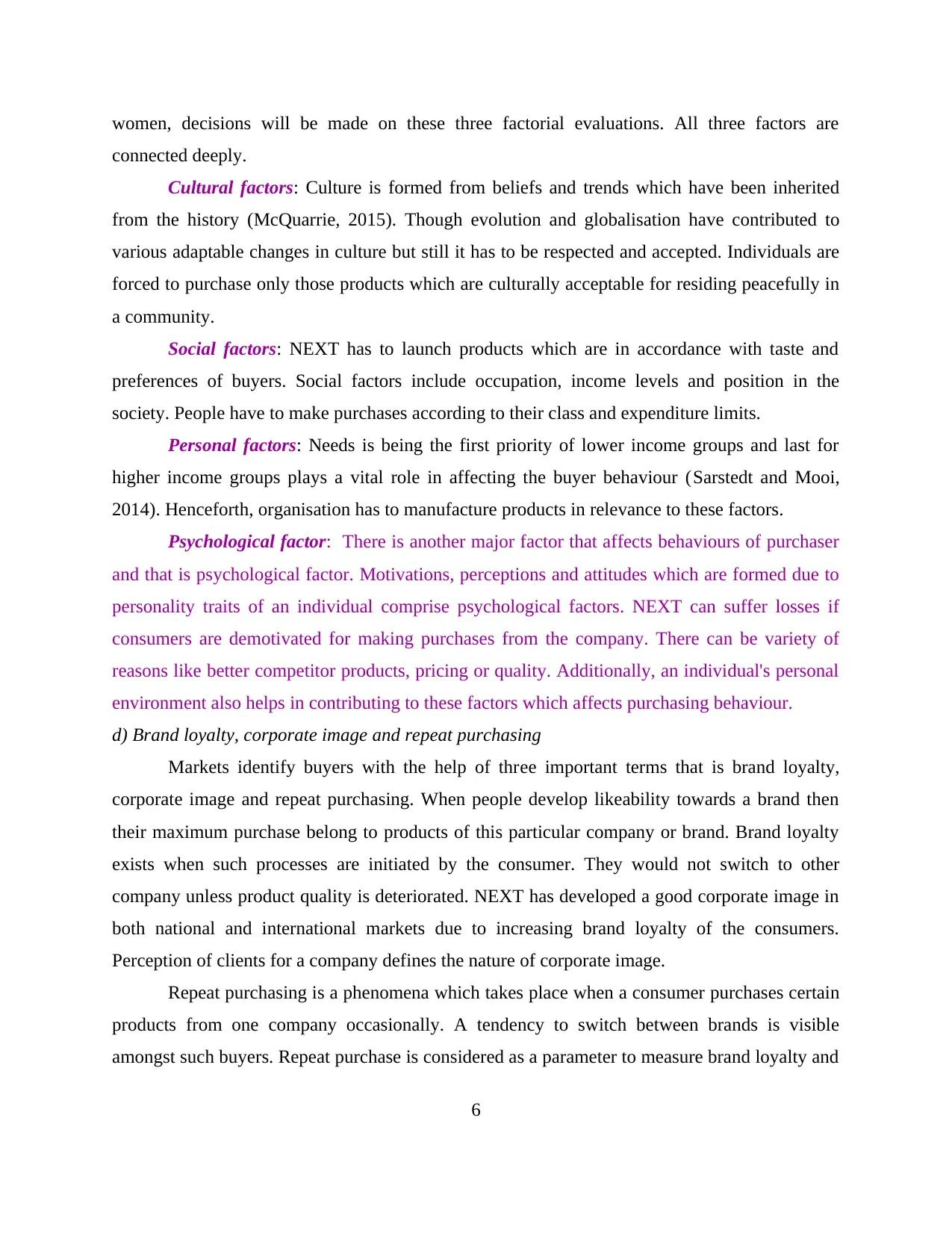
women, decisions will be made on these three factorial evaluations. All three factors are
connected deeply.
Cultural factors: Culture is formed from beliefs and trends which have been inherited
from the history (McQuarrie, 2015). Though evolution and globalisation have contributed to
various adaptable changes in culture but still it has to be respected and accepted. Individuals are
forced to purchase only those products which are culturally acceptable for residing peacefully in
a community.
Social factors: NEXT has to launch products which are in accordance with taste and
preferences of buyers. Social factors include occupation, income levels and position in the
society. People have to make purchases according to their class and expenditure limits.
Personal factors: Needs is being the first priority of lower income groups and last for
higher income groups plays a vital role in affecting the buyer behaviour (Sarstedt and Mooi,
2014). Henceforth, organisation has to manufacture products in relevance to these factors.
Psychological factor: There is another major factor that affects behaviours of purchaser
and that is psychological factor. Motivations, perceptions and attitudes which are formed due to
personality traits of an individual comprise psychological factors. NEXT can suffer losses if
consumers are demotivated for making purchases from the company. There can be variety of
reasons like better competitor products, pricing or quality. Additionally, an individual's personal
environment also helps in contributing to these factors which affects purchasing behaviour.
d) Brand loyalty, corporate image and repeat purchasing
Markets identify buyers with the help of three important terms that is brand loyalty,
corporate image and repeat purchasing. When people develop likeability towards a brand then
their maximum purchase belong to products of this particular company or brand. Brand loyalty
exists when such processes are initiated by the consumer. They would not switch to other
company unless product quality is deteriorated. NEXT has developed a good corporate image in
both national and international markets due to increasing brand loyalty of the consumers.
Perception of clients for a company defines the nature of corporate image.
Repeat purchasing is a phenomena which takes place when a consumer purchases certain
products from one company occasionally. A tendency to switch between brands is visible
amongst such buyers. Repeat purchase is considered as a parameter to measure brand loyalty and
6
connected deeply.
Cultural factors: Culture is formed from beliefs and trends which have been inherited
from the history (McQuarrie, 2015). Though evolution and globalisation have contributed to
various adaptable changes in culture but still it has to be respected and accepted. Individuals are
forced to purchase only those products which are culturally acceptable for residing peacefully in
a community.
Social factors: NEXT has to launch products which are in accordance with taste and
preferences of buyers. Social factors include occupation, income levels and position in the
society. People have to make purchases according to their class and expenditure limits.
Personal factors: Needs is being the first priority of lower income groups and last for
higher income groups plays a vital role in affecting the buyer behaviour (Sarstedt and Mooi,
2014). Henceforth, organisation has to manufacture products in relevance to these factors.
Psychological factor: There is another major factor that affects behaviours of purchaser
and that is psychological factor. Motivations, perceptions and attitudes which are formed due to
personality traits of an individual comprise psychological factors. NEXT can suffer losses if
consumers are demotivated for making purchases from the company. There can be variety of
reasons like better competitor products, pricing or quality. Additionally, an individual's personal
environment also helps in contributing to these factors which affects purchasing behaviour.
d) Brand loyalty, corporate image and repeat purchasing
Markets identify buyers with the help of three important terms that is brand loyalty,
corporate image and repeat purchasing. When people develop likeability towards a brand then
their maximum purchase belong to products of this particular company or brand. Brand loyalty
exists when such processes are initiated by the consumer. They would not switch to other
company unless product quality is deteriorated. NEXT has developed a good corporate image in
both national and international markets due to increasing brand loyalty of the consumers.
Perception of clients for a company defines the nature of corporate image.
Repeat purchasing is a phenomena which takes place when a consumer purchases certain
products from one company occasionally. A tendency to switch between brands is visible
amongst such buyers. Repeat purchase is considered as a parameter to measure brand loyalty and
6
⊘ This is a preview!⊘
Do you want full access?
Subscribe today to unlock all pages.

Trusted by 1+ million students worldwide
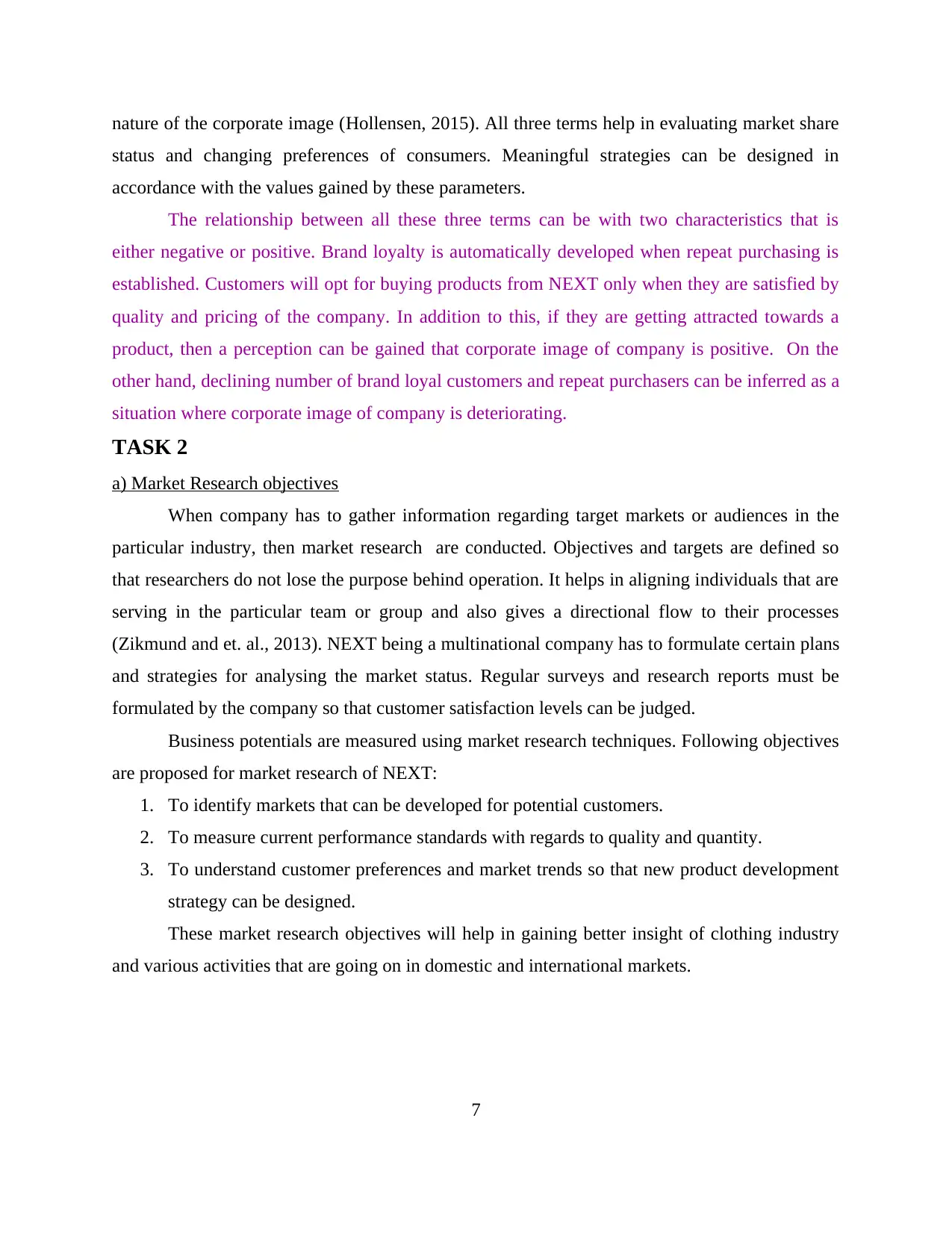
nature of the corporate image (Hollensen, 2015). All three terms help in evaluating market share
status and changing preferences of consumers. Meaningful strategies can be designed in
accordance with the values gained by these parameters.
The relationship between all these three terms can be with two characteristics that is
either negative or positive. Brand loyalty is automatically developed when repeat purchasing is
established. Customers will opt for buying products from NEXT only when they are satisfied by
quality and pricing of the company. In addition to this, if they are getting attracted towards a
product, then a perception can be gained that corporate image of company is positive. On the
other hand, declining number of brand loyal customers and repeat purchasers can be inferred as a
situation where corporate image of company is deteriorating.
TASK 2
a) Market Research objectives
When company has to gather information regarding target markets or audiences in the
particular industry, then market research are conducted. Objectives and targets are defined so
that researchers do not lose the purpose behind operation. It helps in aligning individuals that are
serving in the particular team or group and also gives a directional flow to their processes
(Zikmund and et. al., 2013). NEXT being a multinational company has to formulate certain plans
and strategies for analysing the market status. Regular surveys and research reports must be
formulated by the company so that customer satisfaction levels can be judged.
Business potentials are measured using market research techniques. Following objectives
are proposed for market research of NEXT:
1. To identify markets that can be developed for potential customers.
2. To measure current performance standards with regards to quality and quantity.
3. To understand customer preferences and market trends so that new product development
strategy can be designed.
These market research objectives will help in gaining better insight of clothing industry
and various activities that are going on in domestic and international markets.
7
status and changing preferences of consumers. Meaningful strategies can be designed in
accordance with the values gained by these parameters.
The relationship between all these three terms can be with two characteristics that is
either negative or positive. Brand loyalty is automatically developed when repeat purchasing is
established. Customers will opt for buying products from NEXT only when they are satisfied by
quality and pricing of the company. In addition to this, if they are getting attracted towards a
product, then a perception can be gained that corporate image of company is positive. On the
other hand, declining number of brand loyal customers and repeat purchasers can be inferred as a
situation where corporate image of company is deteriorating.
TASK 2
a) Market Research objectives
When company has to gather information regarding target markets or audiences in the
particular industry, then market research are conducted. Objectives and targets are defined so
that researchers do not lose the purpose behind operation. It helps in aligning individuals that are
serving in the particular team or group and also gives a directional flow to their processes
(Zikmund and et. al., 2013). NEXT being a multinational company has to formulate certain plans
and strategies for analysing the market status. Regular surveys and research reports must be
formulated by the company so that customer satisfaction levels can be judged.
Business potentials are measured using market research techniques. Following objectives
are proposed for market research of NEXT:
1. To identify markets that can be developed for potential customers.
2. To measure current performance standards with regards to quality and quantity.
3. To understand customer preferences and market trends so that new product development
strategy can be designed.
These market research objectives will help in gaining better insight of clothing industry
and various activities that are going on in domestic and international markets.
7
Paraphrase This Document
Need a fresh take? Get an instant paraphrase of this document with our AI Paraphraser
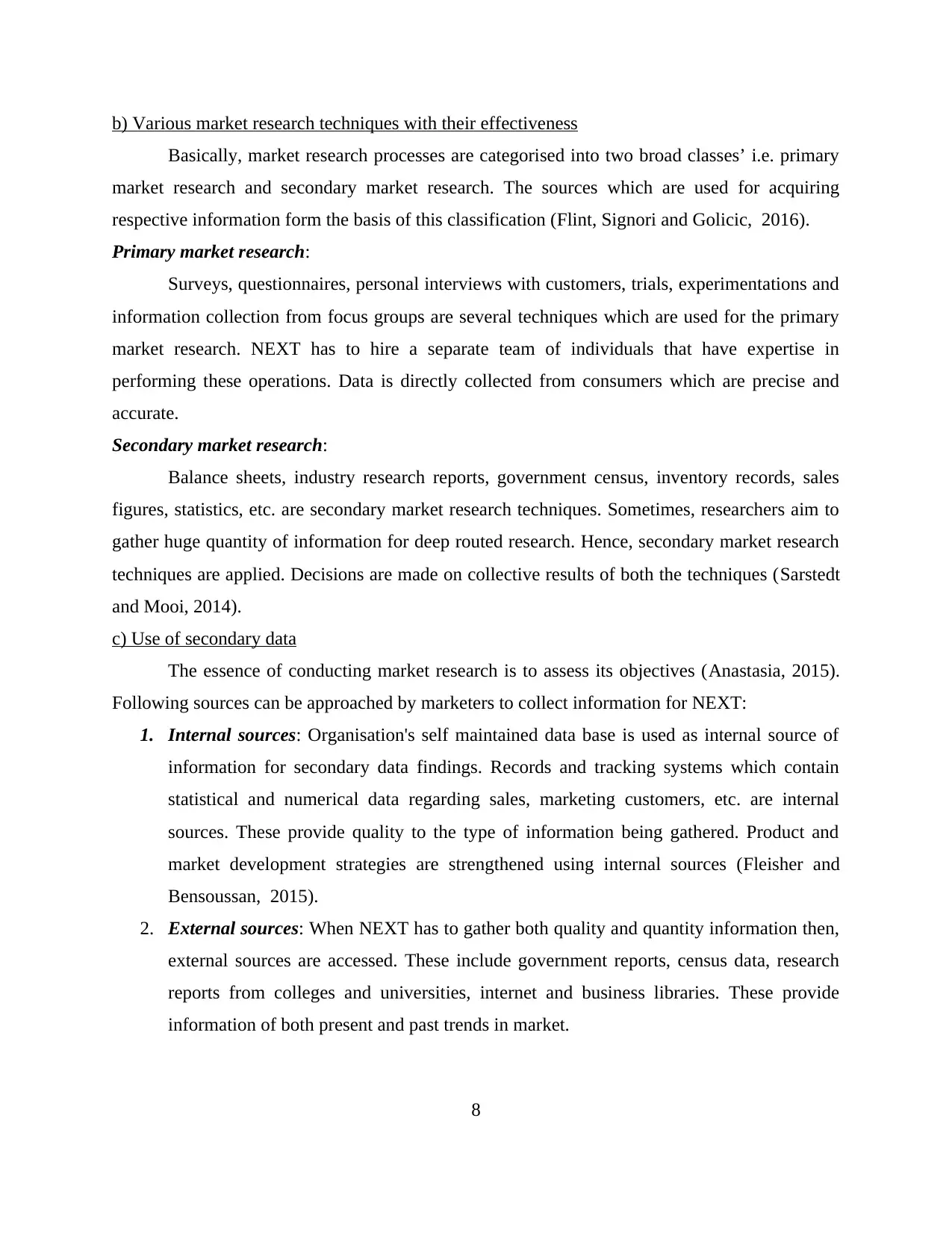
b) Various market research techniques with their effectiveness
Basically, market research processes are categorised into two broad classes’ i.e. primary
market research and secondary market research. The sources which are used for acquiring
respective information form the basis of this classification (Flint, Signori and Golicic, 2016).
Primary market research:
Surveys, questionnaires, personal interviews with customers, trials, experimentations and
information collection from focus groups are several techniques which are used for the primary
market research. NEXT has to hire a separate team of individuals that have expertise in
performing these operations. Data is directly collected from consumers which are precise and
accurate.
Secondary market research:
Balance sheets, industry research reports, government census, inventory records, sales
figures, statistics, etc. are secondary market research techniques. Sometimes, researchers aim to
gather huge quantity of information for deep routed research. Hence, secondary market research
techniques are applied. Decisions are made on collective results of both the techniques (Sarstedt
and Mooi, 2014).
c) Use of secondary data
The essence of conducting market research is to assess its objectives (Anastasia, 2015).
Following sources can be approached by marketers to collect information for NEXT:
1. Internal sources: Organisation's self maintained data base is used as internal source of
information for secondary data findings. Records and tracking systems which contain
statistical and numerical data regarding sales, marketing customers, etc. are internal
sources. These provide quality to the type of information being gathered. Product and
market development strategies are strengthened using internal sources (Fleisher and
Bensoussan, 2015).
2. External sources: When NEXT has to gather both quality and quantity information then,
external sources are accessed. These include government reports, census data, research
reports from colleges and universities, internet and business libraries. These provide
information of both present and past trends in market.
8
Basically, market research processes are categorised into two broad classes’ i.e. primary
market research and secondary market research. The sources which are used for acquiring
respective information form the basis of this classification (Flint, Signori and Golicic, 2016).
Primary market research:
Surveys, questionnaires, personal interviews with customers, trials, experimentations and
information collection from focus groups are several techniques which are used for the primary
market research. NEXT has to hire a separate team of individuals that have expertise in
performing these operations. Data is directly collected from consumers which are precise and
accurate.
Secondary market research:
Balance sheets, industry research reports, government census, inventory records, sales
figures, statistics, etc. are secondary market research techniques. Sometimes, researchers aim to
gather huge quantity of information for deep routed research. Hence, secondary market research
techniques are applied. Decisions are made on collective results of both the techniques (Sarstedt
and Mooi, 2014).
c) Use of secondary data
The essence of conducting market research is to assess its objectives (Anastasia, 2015).
Following sources can be approached by marketers to collect information for NEXT:
1. Internal sources: Organisation's self maintained data base is used as internal source of
information for secondary data findings. Records and tracking systems which contain
statistical and numerical data regarding sales, marketing customers, etc. are internal
sources. These provide quality to the type of information being gathered. Product and
market development strategies are strengthened using internal sources (Fleisher and
Bensoussan, 2015).
2. External sources: When NEXT has to gather both quality and quantity information then,
external sources are accessed. These include government reports, census data, research
reports from colleges and universities, internet and business libraries. These provide
information of both present and past trends in market.
8
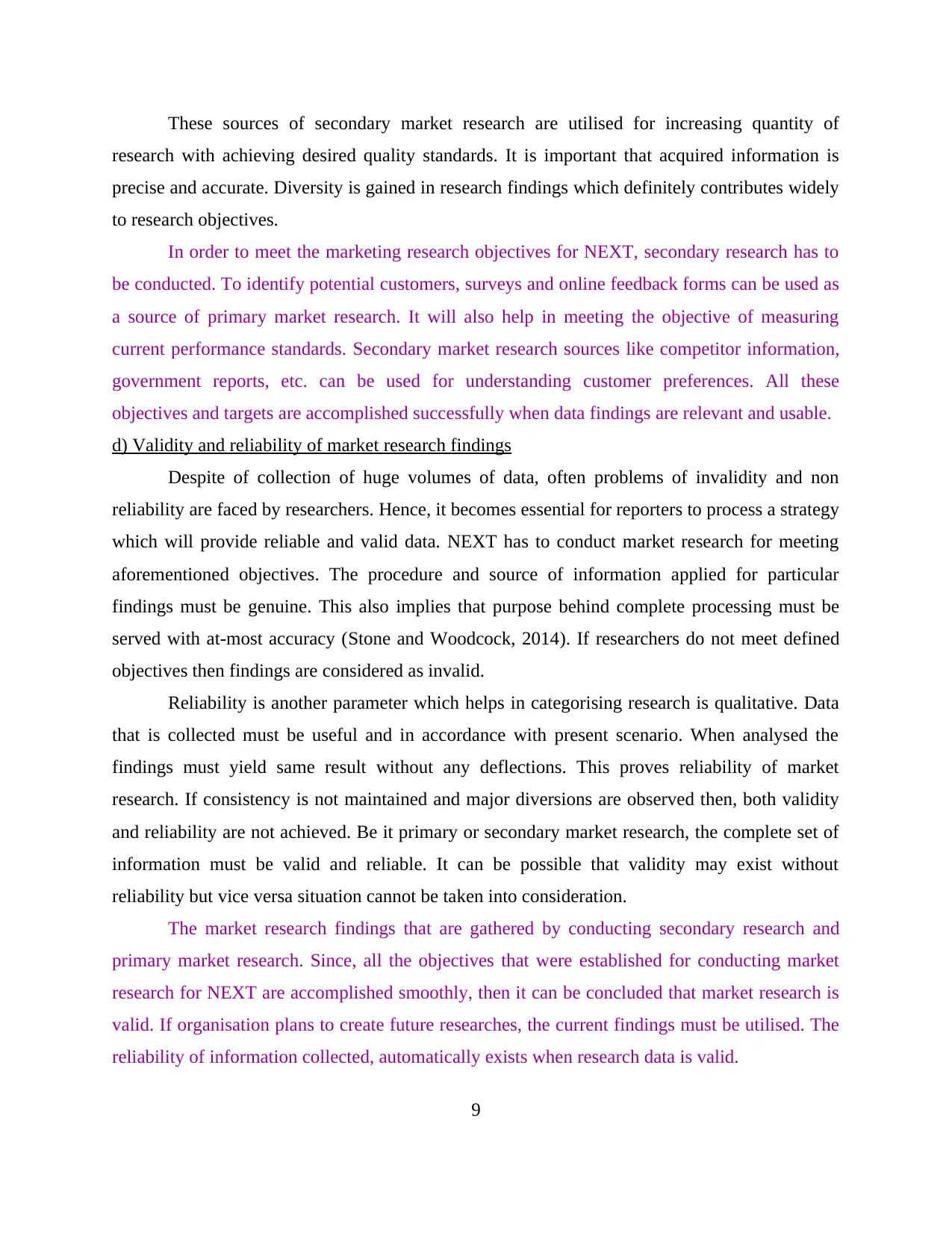
These sources of secondary market research are utilised for increasing quantity of
research with achieving desired quality standards. It is important that acquired information is
precise and accurate. Diversity is gained in research findings which definitely contributes widely
to research objectives.
In order to meet the marketing research objectives for NEXT, secondary research has to
be conducted. To identify potential customers, surveys and online feedback forms can be used as
a source of primary market research. It will also help in meeting the objective of measuring
current performance standards. Secondary market research sources like competitor information,
government reports, etc. can be used for understanding customer preferences. All these
objectives and targets are accomplished successfully when data findings are relevant and usable.
d) Validity and reliability of market research findings
Despite of collection of huge volumes of data, often problems of invalidity and non
reliability are faced by researchers. Hence, it becomes essential for reporters to process a strategy
which will provide reliable and valid data. NEXT has to conduct market research for meeting
aforementioned objectives. The procedure and source of information applied for particular
findings must be genuine. This also implies that purpose behind complete processing must be
served with at-most accuracy (Stone and Woodcock, 2014). If researchers do not meet defined
objectives then findings are considered as invalid.
Reliability is another parameter which helps in categorising research is qualitative. Data
that is collected must be useful and in accordance with present scenario. When analysed the
findings must yield same result without any deflections. This proves reliability of market
research. If consistency is not maintained and major diversions are observed then, both validity
and reliability are not achieved. Be it primary or secondary market research, the complete set of
information must be valid and reliable. It can be possible that validity may exist without
reliability but vice versa situation cannot be taken into consideration.
The market research findings that are gathered by conducting secondary research and
primary market research. Since, all the objectives that were established for conducting market
research for NEXT are accomplished smoothly, then it can be concluded that market research is
valid. If organisation plans to create future researches, the current findings must be utilised. The
reliability of information collected, automatically exists when research data is valid.
9
research with achieving desired quality standards. It is important that acquired information is
precise and accurate. Diversity is gained in research findings which definitely contributes widely
to research objectives.
In order to meet the marketing research objectives for NEXT, secondary research has to
be conducted. To identify potential customers, surveys and online feedback forms can be used as
a source of primary market research. It will also help in meeting the objective of measuring
current performance standards. Secondary market research sources like competitor information,
government reports, etc. can be used for understanding customer preferences. All these
objectives and targets are accomplished successfully when data findings are relevant and usable.
d) Validity and reliability of market research findings
Despite of collection of huge volumes of data, often problems of invalidity and non
reliability are faced by researchers. Hence, it becomes essential for reporters to process a strategy
which will provide reliable and valid data. NEXT has to conduct market research for meeting
aforementioned objectives. The procedure and source of information applied for particular
findings must be genuine. This also implies that purpose behind complete processing must be
served with at-most accuracy (Stone and Woodcock, 2014). If researchers do not meet defined
objectives then findings are considered as invalid.
Reliability is another parameter which helps in categorising research is qualitative. Data
that is collected must be useful and in accordance with present scenario. When analysed the
findings must yield same result without any deflections. This proves reliability of market
research. If consistency is not maintained and major diversions are observed then, both validity
and reliability are not achieved. Be it primary or secondary market research, the complete set of
information must be valid and reliable. It can be possible that validity may exist without
reliability but vice versa situation cannot be taken into consideration.
The market research findings that are gathered by conducting secondary research and
primary market research. Since, all the objectives that were established for conducting market
research for NEXT are accomplished smoothly, then it can be concluded that market research is
valid. If organisation plans to create future researches, the current findings must be utilised. The
reliability of information collected, automatically exists when research data is valid.
9
⊘ This is a preview!⊘
Do you want full access?
Subscribe today to unlock all pages.

Trusted by 1+ million students worldwide
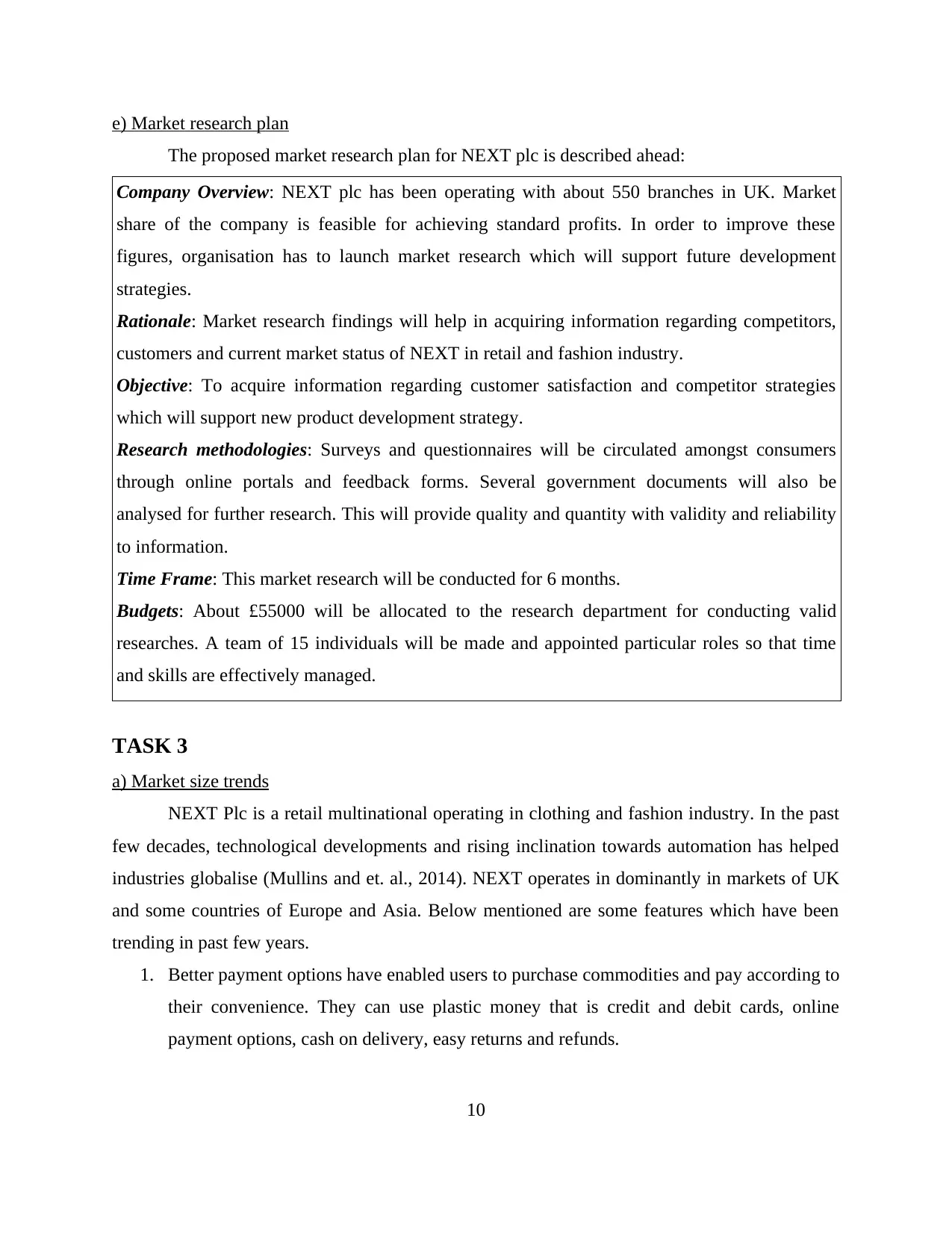
e) Market research plan
The proposed market research plan for NEXT plc is described ahead:
Company Overview: NEXT plc has been operating with about 550 branches in UK. Market
share of the company is feasible for achieving standard profits. In order to improve these
figures, organisation has to launch market research which will support future development
strategies.
Rationale: Market research findings will help in acquiring information regarding competitors,
customers and current market status of NEXT in retail and fashion industry.
Objective: To acquire information regarding customer satisfaction and competitor strategies
which will support new product development strategy.
Research methodologies: Surveys and questionnaires will be circulated amongst consumers
through online portals and feedback forms. Several government documents will also be
analysed for further research. This will provide quality and quantity with validity and reliability
to information.
Time Frame: This market research will be conducted for 6 months.
Budgets: About £55000 will be allocated to the research department for conducting valid
researches. A team of 15 individuals will be made and appointed particular roles so that time
and skills are effectively managed.
TASK 3
a) Market size trends
NEXT Plc is a retail multinational operating in clothing and fashion industry. In the past
few decades, technological developments and rising inclination towards automation has helped
industries globalise (Mullins and et. al., 2014). NEXT operates in dominantly in markets of UK
and some countries of Europe and Asia. Below mentioned are some features which have been
trending in past few years.
1. Better payment options have enabled users to purchase commodities and pay according to
their convenience. They can use plastic money that is credit and debit cards, online
payment options, cash on delivery, easy returns and refunds.
10
The proposed market research plan for NEXT plc is described ahead:
Company Overview: NEXT plc has been operating with about 550 branches in UK. Market
share of the company is feasible for achieving standard profits. In order to improve these
figures, organisation has to launch market research which will support future development
strategies.
Rationale: Market research findings will help in acquiring information regarding competitors,
customers and current market status of NEXT in retail and fashion industry.
Objective: To acquire information regarding customer satisfaction and competitor strategies
which will support new product development strategy.
Research methodologies: Surveys and questionnaires will be circulated amongst consumers
through online portals and feedback forms. Several government documents will also be
analysed for further research. This will provide quality and quantity with validity and reliability
to information.
Time Frame: This market research will be conducted for 6 months.
Budgets: About £55000 will be allocated to the research department for conducting valid
researches. A team of 15 individuals will be made and appointed particular roles so that time
and skills are effectively managed.
TASK 3
a) Market size trends
NEXT Plc is a retail multinational operating in clothing and fashion industry. In the past
few decades, technological developments and rising inclination towards automation has helped
industries globalise (Mullins and et. al., 2014). NEXT operates in dominantly in markets of UK
and some countries of Europe and Asia. Below mentioned are some features which have been
trending in past few years.
1. Better payment options have enabled users to purchase commodities and pay according to
their convenience. They can use plastic money that is credit and debit cards, online
payment options, cash on delivery, easy returns and refunds.
10
Paraphrase This Document
Need a fresh take? Get an instant paraphrase of this document with our AI Paraphraser
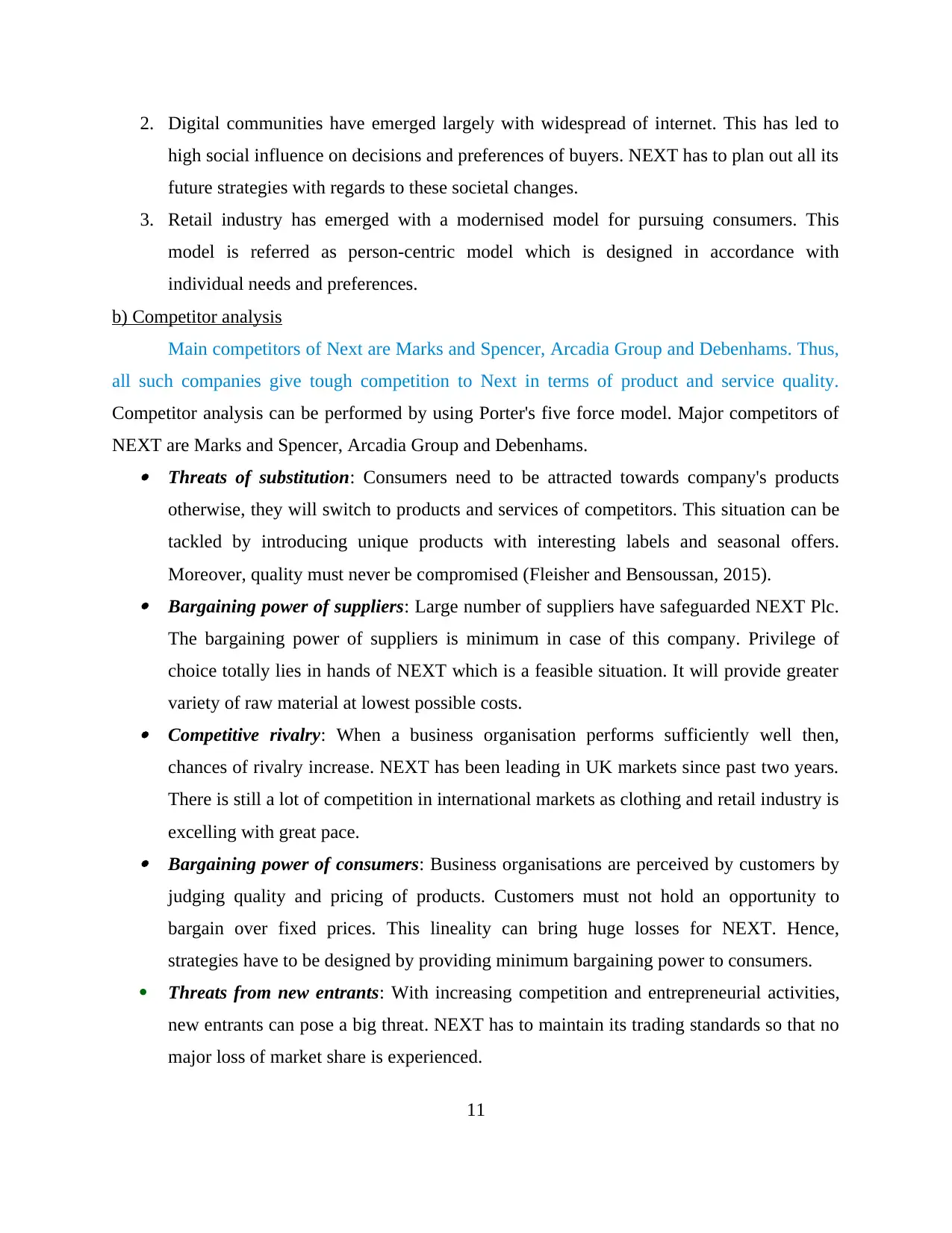
2. Digital communities have emerged largely with widespread of internet. This has led to
high social influence on decisions and preferences of buyers. NEXT has to plan out all its
future strategies with regards to these societal changes.
3. Retail industry has emerged with a modernised model for pursuing consumers. This
model is referred as person-centric model which is designed in accordance with
individual needs and preferences.
b) Competitor analysis
Main competitors of Next are Marks and Spencer, Arcadia Group and Debenhams. Thus,
all such companies give tough competition to Next in terms of product and service quality.
Competitor analysis can be performed by using Porter's five force model. Major competitors of
NEXT are Marks and Spencer, Arcadia Group and Debenhams. Threats of substitution: Consumers need to be attracted towards company's products
otherwise, they will switch to products and services of competitors. This situation can be
tackled by introducing unique products with interesting labels and seasonal offers.
Moreover, quality must never be compromised (Fleisher and Bensoussan, 2015). Bargaining power of suppliers: Large number of suppliers have safeguarded NEXT Plc.
The bargaining power of suppliers is minimum in case of this company. Privilege of
choice totally lies in hands of NEXT which is a feasible situation. It will provide greater
variety of raw material at lowest possible costs. Competitive rivalry: When a business organisation performs sufficiently well then,
chances of rivalry increase. NEXT has been leading in UK markets since past two years.
There is still a lot of competition in international markets as clothing and retail industry is
excelling with great pace. Bargaining power of consumers: Business organisations are perceived by customers by
judging quality and pricing of products. Customers must not hold an opportunity to
bargain over fixed prices. This lineality can bring huge losses for NEXT. Hence,
strategies have to be designed by providing minimum bargaining power to consumers.
Threats from new entrants: With increasing competition and entrepreneurial activities,
new entrants can pose a big threat. NEXT has to maintain its trading standards so that no
major loss of market share is experienced.
11
high social influence on decisions and preferences of buyers. NEXT has to plan out all its
future strategies with regards to these societal changes.
3. Retail industry has emerged with a modernised model for pursuing consumers. This
model is referred as person-centric model which is designed in accordance with
individual needs and preferences.
b) Competitor analysis
Main competitors of Next are Marks and Spencer, Arcadia Group and Debenhams. Thus,
all such companies give tough competition to Next in terms of product and service quality.
Competitor analysis can be performed by using Porter's five force model. Major competitors of
NEXT are Marks and Spencer, Arcadia Group and Debenhams. Threats of substitution: Consumers need to be attracted towards company's products
otherwise, they will switch to products and services of competitors. This situation can be
tackled by introducing unique products with interesting labels and seasonal offers.
Moreover, quality must never be compromised (Fleisher and Bensoussan, 2015). Bargaining power of suppliers: Large number of suppliers have safeguarded NEXT Plc.
The bargaining power of suppliers is minimum in case of this company. Privilege of
choice totally lies in hands of NEXT which is a feasible situation. It will provide greater
variety of raw material at lowest possible costs. Competitive rivalry: When a business organisation performs sufficiently well then,
chances of rivalry increase. NEXT has been leading in UK markets since past two years.
There is still a lot of competition in international markets as clothing and retail industry is
excelling with great pace. Bargaining power of consumers: Business organisations are perceived by customers by
judging quality and pricing of products. Customers must not hold an opportunity to
bargain over fixed prices. This lineality can bring huge losses for NEXT. Hence,
strategies have to be designed by providing minimum bargaining power to consumers.
Threats from new entrants: With increasing competition and entrepreneurial activities,
new entrants can pose a big threat. NEXT has to maintain its trading standards so that no
major loss of market share is experienced.
11
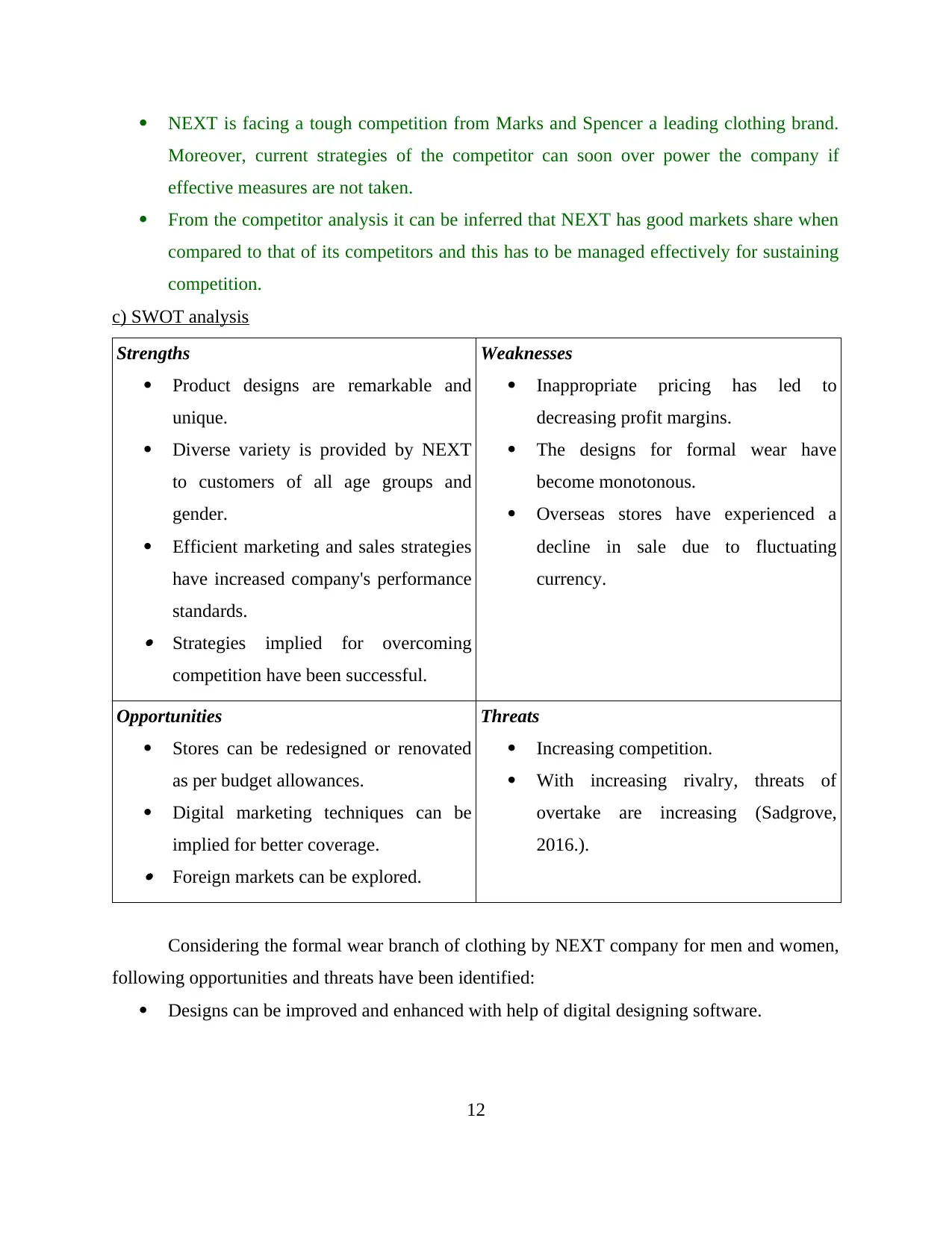
NEXT is facing a tough competition from Marks and Spencer a leading clothing brand.
Moreover, current strategies of the competitor can soon over power the company if
effective measures are not taken.
From the competitor analysis it can be inferred that NEXT has good markets share when
compared to that of its competitors and this has to be managed effectively for sustaining
competition.
c) SWOT analysis
Strengths
Product designs are remarkable and
unique.
Diverse variety is provided by NEXT
to customers of all age groups and
gender.
Efficient marketing and sales strategies
have increased company's performance
standards. Strategies implied for overcoming
competition have been successful.
Weaknesses
Inappropriate pricing has led to
decreasing profit margins.
The designs for formal wear have
become monotonous.
Overseas stores have experienced a
decline in sale due to fluctuating
currency.
Opportunities
Stores can be redesigned or renovated
as per budget allowances.
Digital marketing techniques can be
implied for better coverage. Foreign markets can be explored.
Threats
Increasing competition.
With increasing rivalry, threats of
overtake are increasing (Sadgrove,
2016.).
Considering the formal wear branch of clothing by NEXT company for men and women,
following opportunities and threats have been identified:
Designs can be improved and enhanced with help of digital designing software.
12
Moreover, current strategies of the competitor can soon over power the company if
effective measures are not taken.
From the competitor analysis it can be inferred that NEXT has good markets share when
compared to that of its competitors and this has to be managed effectively for sustaining
competition.
c) SWOT analysis
Strengths
Product designs are remarkable and
unique.
Diverse variety is provided by NEXT
to customers of all age groups and
gender.
Efficient marketing and sales strategies
have increased company's performance
standards. Strategies implied for overcoming
competition have been successful.
Weaknesses
Inappropriate pricing has led to
decreasing profit margins.
The designs for formal wear have
become monotonous.
Overseas stores have experienced a
decline in sale due to fluctuating
currency.
Opportunities
Stores can be redesigned or renovated
as per budget allowances.
Digital marketing techniques can be
implied for better coverage. Foreign markets can be explored.
Threats
Increasing competition.
With increasing rivalry, threats of
overtake are increasing (Sadgrove,
2016.).
Considering the formal wear branch of clothing by NEXT company for men and women,
following opportunities and threats have been identified:
Designs can be improved and enhanced with help of digital designing software.
12
⊘ This is a preview!⊘
Do you want full access?
Subscribe today to unlock all pages.

Trusted by 1+ million students worldwide
1 out of 20
Related Documents
Your All-in-One AI-Powered Toolkit for Academic Success.
+13062052269
info@desklib.com
Available 24*7 on WhatsApp / Email
![[object Object]](/_next/static/media/star-bottom.7253800d.svg)
Unlock your academic potential
Copyright © 2020–2025 A2Z Services. All Rights Reserved. Developed and managed by ZUCOL.





